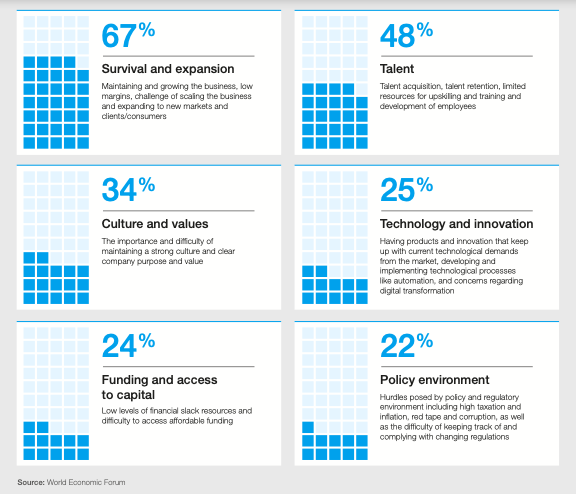Small and Medium-sized Enterprises (SMEs) are crucial drivers of economic growth and employment in the world. However, these enterprises face a multitude of challenges that hinder their growth potential. Let’s look at the current challenges faced by SMEs as per the World Economic Forum (WEF), especially in India and Europe, and let’s explore the potential solutions from our team of experts at KeyPulse.
Challenges Faced by SMEs
Before we talk about the challenges faced by SMEs, let’s have a look at all the challenges faced by SMEs (as per WEF) in a glance (and the percentage) –

As you can see, the most critical challenges of all are survival and expansion. And the more alarming aspect is 67% of SMEs are just fighting for survival. And when SMEs are the backbone of the economy in a country, this throbbing pain must be solved.
Along with survival and expansion, SMEs also suffer from finding & attracting the right talent, dealing with culture and values, technology and innovation, funding, and policy environment.
Let’s understand each challenge with some perspective and data.
Challenge#1: Survival & Expansion
Post-COVID-19, the context and perspective for the SMEs have changed dramatically. For financial fragility, smaller cash backups, and lower implementation of digital technologies and tools, COVID-19 has sucked the SMEs into a black hole and many have shut down shops.
Now, even if COVID-19 has subsided, the scenario hasn’t changed much. As per the report of the World Economic Forum, 67%, i.e. two-thirds of the SMEs have been struggling with survival and expansion.
The need of the hour is to realize the two most critical things.
Adaptive Capacity
Even if the size of the organization is smaller, the power of resilience and adaptability is more for any SME. They need to use that power to remain afloat and become technologically stronger. They can cut costs on the overheads which are not generating ROIs for their business in the long run and use that money to upgrade their digital presence.
Sustainable Innovation
Use the power of Kaizen and improve a little every day. And when you aim for transforming your digital presence, KeyPulse’s kProcess and other critical solutions will help you automate data and help you make an informed decision from the data sets.
Challenge#2: Talent
As per the World Economic Report, 48% of SMEs struggle with hiring, retaining the best talents, and training the top talents. And this is the second most critical challenge SMEs face.
Limited resources and competition from larger corporations also make it difficult for SMEs to attract skilled individuals.
Moreover, the inability to offer extensive employee benefits and career advancement opportunities can hinder retention efforts.
SMEs often struggle to provide comprehensive training and development programs due to budget constraints.
To overcome these challenges, SMEs can focus on creating a strong employer brand, offering flexible work arrangements, providing opportunities for growth and learning, and leveraging partnerships with educational institutions and training providers to access affordable training solutions.
Along with that if SMEs start using KeyPulse’s kTime, resource utilization would be a piece of cake.
Challenge#3: Culture & Values
Around 34% of SMEs aren’t able to create a strong culture and values due to several reasons.
As these enterprises grow, it becomes increasingly difficult to uphold and transmit their core values and culture consistently. SMEs often face the risk of dilution or distortion of their original culture due to rapid expansion, diverse workforce, and evolving dynamics.
Limited resources may hinder the implementation of robust culture-building initiatives. To address this challenge, SMEs should prioritize clear communication of values, establish strong leadership with a focus on culture, involve employees in shaping the organizational culture, foster a sense of belonging and shared purpose, and invest in ongoing training and development to reinforce the desired culture throughout the company.
When you use KeyPulse’s kTime and kControl, you will be able to utilize your resources effectively and also be able to proactively offer predictive maintenance.
Challenge#4: Technology & Innovation
25% of small businesses struggle to keep pace with rapidly evolving technologies and lack the resources to invest in cutting-edge solutions. This puts them at a disadvantage compared to larger competitors who can afford to adopt and leverage advanced technologies. Limited technical expertise and resistance to change can also impede the adoption of innovative practices.
However, in today’s digital age, embracing technology and undergoing digital transformation is crucial for SMEs to remain competitive and thrive in the market. Here’s why:
Enhanced Efficiency and Productivity
Digital tools and automation can streamline processes, improve operational efficiency, and reduce costs. By adopting technology, SMEs can optimize workflows, eliminate manual tasks, and allocate resources more effectively, leading to increased productivity and profitability.
Expanded Market Reach
Digital transformation enables SMEs to access new markets and customers. Through online platforms, e-commerce, and digital marketing strategies, small businesses can overcome geographical limitations, expand their customer base, and target specific market segments, both domestically and globally.
Improved Customer Experience
Technology empowers SMEs to deliver a better customer experience. From personalized communication and seamless online transactions to efficient customer support, digital tools enable small businesses to meet customer expectations, build loyalty, and gain a competitive edge.
Agility and Adaptability
In a rapidly changing business landscape, digital transformation equips SMEs with the agility and adaptability required to respond to market trends and customer demands swiftly. Technology enables businesses to gather and analyze data, derive insights, and make informed decisions, enabling them to stay ahead of the competition.
Innovation and Creativity
Embracing technology encourages a culture of innovation within SMEs. By adopting digital solutions, small businesses can explore new business models, develop innovative products or services, and leverage emerging technologies like artificial intelligence, blockchain, or the Internet of Things to gain a competitive advantage.
To up their game and overcome challenges, SMEs need to embrace digital transformation and make sure that they use the right tools to scale faster. It not only improves operational efficiency, expands market reach, and enhances customer experience but also fosters innovation and ensures long-term sustainability in today’s technology-driven business landscape.
Challenge#5: Funding and Access to Capital
Lack of adequate funding remains a significant obstacle for around 24% of SMEs. According to the International Finance Corporation (IFC), approximately 65 million firms, accounting for 40% of formal micro, small, and medium enterprises (MSMEs) in developing countries, face an unmet financing need of $5.2 trillion annually. This staggering amount is equivalent to 1.4 times the current level of global MSME lending.
The regional distribution of this finance gap is as follows: East Asia and the Pacific held the largest share at 46%, followed by Latin America and the Caribbean at 23%, and Europe and Central Asia at 15%.
The volume of this gap varies significantly across regions. Notably, Latin America and the Caribbean, along with the Middle East and North Africa, exhibit the highest proportion of the finance gap in relation to potential demand, reaching 87% and 88%, respectively.
Additionally, nearly half of the formal SMEs lack access to formal credit, and when considering micro and informal enterprises, the financing gap expands even further.
Challenge#6: Policy Environment
Around 22% of SMEs often grapple with complex and time-consuming regulatory procedures.
Obtaining licenses, complying with tax regulations, and addressing bureaucratic hurdles can be a daunting task, consuming valuable resources and hindering business growth.
SMEs often face barriers to accessing international markets due to regulatory complexities, trade barriers, and limited resources. This hinders their growth potential and reduces opportunities for expanding customer bases and revenue streams.
Possible Solutions by the expert team at KeyPulse
Enhanced Access to Finance
Governments and financial institutions should collaborate to develop innovative financial products and platforms tailored to SMEs. Encouraging alternative financing options such as venture capital, crowdfunding, and microfinance can provide SMEs with much-needed capital.
Simplification of Regulations
Governments should streamline and simplify regulatory procedures, reducing red tape and administrative burdens. Digitization of processes, such as online licensing and tax compliance, can significantly reduce the time and effort required by SMEs to navigate regulatory frameworks.
Skills Development and Training
Governments and industry stakeholders must invest in skilling initiatives, vocational training programs, and apprenticeships. This would bridge the skills gap and ensure a pool of qualified talent for SMEs to recruit from.
Digital Support
Governments and organizations should provide training and resources to enable SMEs to embrace digital technologies. Support in areas like e-commerce, cybersecurity, data analytics, and digital marketing can enhance SMEs’ competitiveness and market reach.
The SMEs should also look at the available tools in the market like kProcess to transform digitally and scale faster.
International Support
Governments should facilitate SMEs’ access to international markets through trade agreements, export promotion schemes, and market development initiatives. Assisting in navigating trade barriers and fostering collaborations can open up new growth opportunities.
Conclusion
SMEs in both India and Europe face a range of challenges that hinder their growth and competitiveness. By addressing the financing gap, simplifying regulations, investing in skills development, promoting digitalization, and facilitating internationalization, governments and stakeholders can empower SMEs to overcome these obstacles. Collaborative efforts are necessary to unleash the full potential of SMEs and leverage their pivotal role in driving economic growth and job creation.

